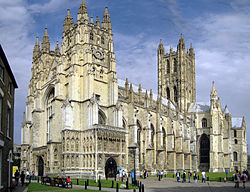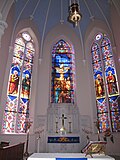Churchmanship
 From Wikipedia - Reading time: 10 min
From Wikipedia - Reading time: 10 min
| Part of a series on |
| Anglicanism |
|---|
 |
|
|
| Part of a series on |
| Lutheranism |
|---|
 |
Churchmanship (also churchpersonship, or tradition in most official contexts) is a way of talking about and labelling different tendencies, parties, or schools of thought within the Church of England and the sister churches of the Anglican Communion. The term has been used in Lutheranism in a similar fashion.
Anglicanism
[edit]In Anglicanism parties can include, from highest to lowest, Anglo-Papalist, Anglo-Catholic, Prayer Book Catholic, Old High/Center, Broad, Low/Evangelical.
The term is derived from the older noun churchman, which originally meant an ecclesiastic or clergyman but, some while before 1677, it was extended to people who were strong supporters of the Church of England and, by the nineteenth century, was used to distinguish between Anglicans and Dissenters. The word "churchmanship" itself was first used in 1680 to refer to the attitude of these supporters but later acquired its modern meaning. While many Anglicans are content to label their own churchmanship, not all Anglicans would feel happy to be described as anything but "Anglican".[1] Today, in official contexts, the term "tradition" is sometimes preferred.
"High" and "Low", the oldest labels, date from the late seventeenth century and originally described opposing political attitudes to the relation between the Church of England and the civil power. Their meaning shifted as historical settings changed and, towards the end of the nineteenth century, they had come to be used to describe different views on the ceremonies to be used in worship. Shortly after the introduction of the "High/Low" distinction a section of the "Low" Church was nicknamed Latitudinarian because of its relative indifference to doctrinal definition. In the nineteenth century this group gave birth to the Broad Church which, in turn, produced the "Modernist" movement of the first half of the twentieth century. Today, the "parties" are usually thought of as Anglo-Catholics, evangelical Anglicans, and Liberals and, with the exception of "High Church", the remaining terms are mainly used to refer to past history. The precise shades of meaning of any term vary from user to user and mixed descriptions such as liberal-catholic are found. Today "Broad Church" may be used in a sense that differs from the historical one mentioned above and identifies Anglicans who are neither markedly high, nor low/evangelical nor liberal.[2]
It is an Anglican commonplace to say that authority in the church has three sources: Scripture, Reason and Tradition. In general, the Low churchman and the Evangelical tends to put more emphasis upon Scripture, the Broad churchman and the Liberal upon reason and the High churchman or Anglo-Catholic upon tradition.[3][4] The emphasis on "parties" and differences is necessary but in itself gives an incomplete picture. Cyril Garbett (later Archbishop of York) wrote of his coming to the Diocese of Southwark:
I found the different parties strongly represented with their own organizations and federations... But where there was true reverence and devotion I never felt any difficulty in worshipping and preaching in an Anglo-Catholic church in the morning and in an Evangelical church in the evening"... and when there was a call for united action... the clergy and laity without distinction of party were ready to join in prayer, work and sacrifice.
— Garbett, [5]
and William Gibson commented that
the historical attention given to the fleeting moments of controversy in the eighteenth century has masked the widespread and profound commitment to peace and tranquility among both the clergy and the laity.... High Church and Low Church were not exclusive categories of thought and churchmanship. They were blurred and broad streams within Anglicanism that often merged, overlapped and coincided.
— Gibson, [6]
A traditional poem to describe churchmanship is "Low and Lazy, Broad and Hazy, and High and Crazy." Lazy refers to simpler worship, hazy to unclear tradition or beliefs, and crazy to excessive ceremonialism; but the author of the poem may have been a humorist.
In the United States a "churchman" is a member of the Episcopal Church in the United States of America (ECUSA). Usage of the term began in the nineteenth century and has been modified in the twentieth century.[7]
Lutheranism
[edit]Lutheranism has traditionally retained cohesiveness due to doctrinal unity on the Book of Concord.[8]
The concept of churchmanship is used in Lutheranism. In Lutheran churches churchmanship can be liberal, pietist, confessional, high church or evangelical Catholic.[9]
There may be overlap between these categories; for example, the Lutheran Church–International (LC–I) is a confessional Lutheran denomination of Evangelical Catholic churchmanship.[10]
Gallery
[edit]-
Chancel of Newcastle Cathedral (High Church)
-
Altar of St Sepulchre-without-Newgate (Low Church)
-
Interior of St Ann's Church, Manchester (Broad Church)
-
Interior of All Souls Church, Langham Place (Conservative Evangelical Anglicanism)
-
Interior of St Giles Church, Durham (Central churchmanship)
-
Chancel of All Saints, Margaret Street (Anglo-Catholicism)
-
Chancel of St. Matthew's German Evangelical Lutheran Church (Evangelical Catholic)
-
Lutheran Church of the Redeemer (High Church)
See also
[edit]- Central churchmanship
- Liberal Anglo-Catholicism
- Conservative evangelicalism in Britain
- Homosexuality and the Anglican Communion
- Crypto-papism
- Crypto-Calvinism
References
[edit]- ^ Neill, Stephen (1960). Anglicanism. London: Pelican. p. 398.
- ^ Hylson-Smith, Kenneth (1993). High Churchmanship in the Church of England. Edinburgh: T&T Clark. p. 340.
- ^ Holmes III, Urban T. (1982). What is Anglicanism?. Wilton, Connecticut: Moorehouse-Barlow Co. p. 11.
- ^ Carey, George (1996). "Celebrating the Anglican Way". In Bunting, Ian (ed.). Celebrating the Anglican Way. London: Hodder & Stoughton. pp. 14–16.
- ^ Garbett, Cyril (1947). The Claims of the Church of England. London: Hodder & Stoughton. p. 27.
- ^ Gibson, William (2001). The Church of England: 1688-1832. London: Routledge. pp. 1, 2.
- ^ The Churchman's Human Quest (1995–1996). ISSN 0897-8786 & ISSN 0009-6628 – is one of the titles of a periodical which has changed many times.
- ^ "Book of Concord FAQs". Lutheran Reformation. Retrieved 16 May 2025.
The Book of Concord is unique among all churches in the world, since it gathers together the Lutheran Church's most normative expressions of the Christian faith into a single book that has been used for nearly five hundred years as a fixed point of reference for the Lutheran Church.
- ^ Rawlyk, George A. (17 February 1997). Aspects of the Canadian Evangelical Experience. McGill-Queen's Press. p. 248. ISBN 978-0-7735-6648-4.
- ^ "Bulletin: Pentecost and Ordinary Time 2024" (PDF). LC-I. 2024. Retrieved 2 February 2025.
We do not want to provide reasons for those outside of our church body to be confused as to where we stand and for what we stand as a confessional Christian Lutheran church body in the evangelical catholic understanding.
Bibliography
[edit]- Balleine, G. R. (1909). A History of the Evangelical Party. London: Longmans, Green & Co.
- Bebbington, D. W. (1993). Evangelicalism in Modern Britain. London: Routledge.
- Bennett, Gareth (1998). To the Church of England. Worthing, UK: Churchman Publishing Ltd.
- Chadwick, Owen (1996R). The Reformation. London: Adam & Charles Black.
- Chadwick, Owen (1987). The Victorian Church (2 vol). London: Pelican.
- Cragg, Gerald C. The Church and the Age of Reason 1648–1789. London: Pelican (revised 1960).
- Davies, Julian (1992). The Caroline Captivity of the Church. Oxford: Clarendon Press.
- Hylson-Smith, Kenneth (1989). Evangelicals in the Church of England: 1734–1984. Edinburgh: T&T Clark.
- Shahan, Michael (2008). A Report from the Front Lines: Conversations on Public Theology: A Festschrift in Honor of Robert Benne. Wm. B. Eerdmans Publishing. ISBN 978-0-8028-4863-5.
- Smyth, Charles (1962). The Church and the Nation. London: Hodder & Stoughton.
- Rosman, Doreen (2006). The Evolution of the English Churches. Cambridge University Press.
- Spurr, John (1991). The Restoration, Church of England, 1646–1689. London: Yale University Press.
- Trevelyan, G. M. (December 1944). History of England. London: Longman Green & Co.
 KSF
KSF






